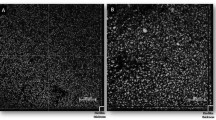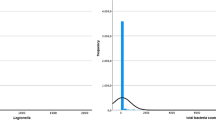Abstract
Vermamoeba vermiformis is associated with the biofilm ecology of dental-unit waterlines (DUWLs). This study investigated whether V. vermiformis is able to act as a vector for potentially pathogenic bacteria and so aid their dispersal within DUWL systems. Clinical dental water was initially examined for Legionella species by inoculating it onto Legionella selective-medium plates. The molecular identity/profile of the glassy colonies obtained indicated none of these isolates were Legionella species. During this work bacterial colonies were identified as a non-pigmented Serratia marcescens. As the water was from a clinical DUWL which had been treated with Alpron™, this prompted the question as to whether S. marcescens had developed resistance to the biocide. Exposure to Alpron™ indicated that this dental biocide was effective, under laboratory conditions, against S. marcescens at up to 1 × 108 colony forming units/millilitre (cfu/ml). V. vermiformis was cultured for 8 weeks on cells of S. marcescens and Escherichia coli. Subsequent electron microscopy showed that V. vermiformis grew equally well on S. marcescens and E. coli (P = 0.0001). Failure to detect the presence of S. marcescens within the encysted amoebae suggests that V. vermiformis is unlikely to act as a vector supporting the growth of this newly isolated, nosocomial bacterium.


Similar content being viewed by others
References
Al Shorman H, Nabaa LA, Coulter WA, Pankhurst CL, Lynch E (2002) Management of dental unit water lines. Dent Update 29:292–298
American Dental Association (ADA) (2004) Statement on dental unit waterline. http://www.ada.org/1856.aspx. Accessed 25 April 2015
Anon (1993) Council Directive 93/42/EEC of 14 June 1993 concerning medical devices. OJEUL 169:1–43
Anwar H, Costerton JW (1990) Enhanced activity of combination of tobramycin and piperacillin for eradication of sessile biofilm cells of Pseudomonas aeruginosa. Antimicrob Agents Chemother 34:1666–1671
Atlas RM, Williams JF, Huntington MK (1995) Legionella contamination of dental-unit waters. Appl Environ Microbiol 61:1208–1213
Barbaree JM, Fields BS, Feeley JC, Gorman GW, Martin WT (1986) Isolation of protozoa from water associated with a Legionellosis outbreak and demonstration of intracellular multiplication of Legionella pneumophila. Appl Environ Microbiol 51:422–424
Barbeau J, Buhler T (2001) Biofilms augment the number of free-living amoebae in dental unit water lines. Res Microbiol 152:75–760
Barbeau J (2007) Lawsuit against a dentist related to serious ocular infection possibly linked to water from a dental handpiece. J Can Dent Assoc 73:618–622
Barbot V, Robert A, Rodier M, Imbert C (2012) Update on infectious risks associated with dental unit waterlines. FEMS Immunol Med Microbiol 65:196–204
Barbot V, Costa D, Deborde M, Imbert C (2014) Efficacy of dental unit disinfectants against Candida spp. and Hartmannella vermiformis. Pathog Dis 70(3):289–296
Blake GC (1963) The incidence and control of bacterial infection in dental spray reservoirs. Br Dent J 115:413–416
Cateau E, Imbert C, Rodier MH (2008) Hartmannella vermiformis can be permissive for P. aeruginosa. Lett Appl Microbiol 47:475–477
Chate RA (2010) An audit improves the quality of water within the dental unit water lines of general dental practices across the East of England. Br Dent J 209(7):E11
Dillon A, Achilles-Day U, Singhrao SK, Pearce M, Morton LHG, Crean S (2014) Biocide sensitivity of Vermamoeba vermiformis isolated from dental-unit-waterline systems. Int Biodeter Biodegr 88:97–105
Dillon A, Singhrao SK, Achilles-Day U, Pearce M, Morton LHG, Crean S (2014) Vermamoeba vermiformis does not propagate Legionella pneumophila subsp. pascullei in a simulated laboratory dental-unit-waterline system. Int Biodeter Biodegr 90:1–7
Domingue G, Ellis B, Dasgupta M, Costerton JW (1994) Testing antimicrobial susceptibilities of adherent bacteria by a method that incorporates guidelines of the National Committee for Clinical Laboratory Standards. J Clin Microbiol 32:2564–2568
D’Ovidio C, Carnevale A, Pantaleone G, Piattelli A, Di Bonaventura G (2011) First report of an acute purulent maxillary sinusitis caused by Pseudomonas aeruginosa secondary to dental implant placement in an immunocompetent patient. Br Dent J 211:205–207
Equi RA, Green WR (2001) Endogenous Serratia marcescens endophthalmitis with dark hypopyon: case report and review. Surv Ophthalmol 46(3):259–268
Fields BS, Fields SR, Chin Loy JN, White EW, Steffens WL, Shotts EB (1993) Attachment and entry of Legionella pneumophila in Hartmannella vermiformis. J Infect Dis 167:1146–1150
Groscop JA, Brent MM (1964) The effects of selected strains of pigmented microorganisms on small free-living amoebae. Can J Microbiol 10:579–584
Hejazi A, Falkiner FR (1997) Serratia marcescens. J Med Microbiol 46(11):903–912
Henke M, Seidel KM (1986) Association between Legionella pneumophila and amoebae in water. Isr J Med Sci 22:690–695
Kohn W, Collins A, Cleveland J, Harte J, Eklund K, Malvitz D (2003) Guidelines for infection control in dental health-care settings. MMWR. Recommendations and Reports/Centers for Disease Control [serial online] 52(RR-17): 1–61. http://www.cdc.gov/mmwr/preview/mmwrhtml/rr5217a1.htm. Accessed 1 May 2015
Lal S, Singhrao SK, Bricknell M, Pearce M, Morton LHG, Ahmed W, Crean S (2014) Monitoring dental unit water line output water by current in-office test kits. Curr Microbiol 69(2):135–142
Langeland K (1972) Prevention of pulpal damage. Dent Clin N Am 16:709–732
Marciano-Cabral F, Jamerson M, Kaneshiro ES (2010) Free-living amoebae, Legionella and Mycobacterium in tap water supplied by a municipal drinking water utility in the USA. J Water Health 8(1):71–82
Martin M (1987) The significance of the bacterial contamination of dental unit water systems. Br Dent J 163:152–154
Maseda H, Hashida Y, Konaka R, Shirai A, Kourai H (2009) Mutational upregulation of a resistance-nodulation-cell division-type multidrug efflux pump, SdeAB, upon exposure to a biocide, cetylpyridinium chloride, and antibiotic resistance in Serratia marcescens. Antimicrob Agents Chemother 53(12):5230–5235
Maseda H, Hashida Y, Shirai A, Omasa T, Nakae T (2011) Mutation in the sdeS gene promotes expression of the sdeAB efflux pump genes and multidrug resistance in Serratia marcescens. Antimicrob Agents Chemother 55(6):2922–2926
McEntegart MG, Clark A (1973) Colonisation of dental units by water bacteria. Br Dent J 34:140–142
Michel R, Just HM (1984) Acanthamoebae, Naegleria and other free-living Amoebae in cooling and rinsing water of dental treatment units. Zentralbl Bakteriol Mikrobiol Hyg B 179:56–72
Michel R, Borneff M (1989) The significance of amoebae and other protozoa in water conduit systems in dental units. Zentralbl Bakteriol Mikrobiol Hyg B 187:312–323
Miles AA, Misra SS (1938) The estimation of the bactericidal power of the blood. J Hyg 38:732–749
Moskowitz SM, Foster JM, Emerson J, Burns JL (2004) Clinically feasible biofilm susceptibility assay for isolates of Pseudomonas aeruginosa from patients with cystic fibrosis. J Clin Microbiol 42:1915–1922
Nazar M, Haghighi A, Taghipour N, Ortega-Rivas A, Tahvildar-Biderouni F, Nazemalhosseini Mojarad E, Eftekhar M (2012) Molecular identification of Hartmannella vermiformis and Vannella persistens from man-made recreational water environments, Tehran, Iran. Parasitol Res 111:835–839
Oppenheim BA, Sefton AM, Gill ON, Tyler JE, O’Mahony MC, Richards JM, Dennis PJ, Harrison TG (1987) Widespread Legionella pneumophila contamination of dental stations in a dental school without apparent human infection. Epidemiol Infect 99:159–166
Pankhurst CL, Philpott-Howard JN (1993) The microbiological quality of water in dental chair units. J Hosp Infect 23:167–174
Pankhurst CL, Johnson NW, Woods RG (1998) Microbial contamination of dental unit waterlines: the scientific argument. Int Dent J 48:359–368
Pearce M, O’Donnell H, Singhrao SK, Crean S (2013) Assessing water discharged from dental units using Dip Slides™. Br Soc Oral Dent Res. Abstract number 181571
Pickup Z, Pickup R, Parry JD (2007) Effects of bacterial prey species and their concentration on growth of the Amoebae Acanthamoeba castellanii and Hartmannella vermiformis. Appl Environ Microbiol 73:2631–2634
Pickup Z, Pickup R, Parry JD (2007) A comparison of the growth and starvation responses of Acanthamoeba castellanii and Hartmannella vermiformis in the presence of suspended and attached Escherichia coli K12. FEMS Microbiol Ecol 59:556–563
Porteous NB, Redding SW, Jorgensen JH (2004) Isolation of non-tuberculosis Mycobacteria in treated dental unit waterlines. Oral Surg Oral Med Oral Pathol Oral Radiol Endod 98:40–44
Rice EW, Rich WK, Johnson CH, Lye DJ (2006) The role of flushing dental water lines for the removal of microbial contaminants. Public Health Rep 121:270–274
Ricci ML, Fontana S, Pinci F, Fiumana E, Pedna MF, Farolfi P, Sabattini MA, Scaturro M (2012) Pneumonia associated with a dental unit waterline. Lancet 379:684
Rowland BR, Voorheesville NY (2003) Bacterial contamination of dental unit waterlines: what is your dentist spraying into your mouth. Clin Microbiol Newsl 25(10):73–77
Salah IB, Ghigo E, Drancourt M (2009) Free-living amoebae, a training field for macrophage resistance of mycobacteria. Clin Microbiol Infect 15(10):894–905
Sandstrom G, Saeed A, Abd H (2010) Acanthamoeba polyphaga is a possible host for Vibrio cholerae in aquatic environments. Exp Parasitol 126(1):65–68
Schulze-Robbecke R, Feldman C, Fischeder R (1995) Dental units: an environmental study of sources of potentially pathogenic Mycobacteria. Tuber Lung Dis 76:318–323
Siegel SC, von Fraunhofer JA (2002) The effect of hand piece spray patterns on cutting efficiency. J Am Dent Assoc 133:184–188
Singh BN (1942) Toxic effects of certain bacterial metabolic products on soil protozoa. Nature 149:168
Singh T, Coogan MM (2005) Isolation of pathogenic Legionella species and Legionella-laden amoebae in dental unit waterlines. J Hosp Infect 61:257–262
Stanley HR (1971) Pulpal response to dental techniques and materials. Dent Clin N Am 15:115–126
Tan N, Galvante PR, Chee SP (2014) Endogenous Serratia marcescens endophthalmitis: an atypical presentation. Eye (Lond) 28(1):108–109
Wadowsky RM, Butler LJ, Cook MK, Verma SM, Paul MA, Fields BS, Keleti G, Sykora JL, Yee RB (1988) Growth supporting activity for Legionella pneumophila in tap water cultures and implication of Hartmannellid amoebae as growth factors. Appl Environ Microbiol 54:2677–2682
Wang SS, Feldman HA (1967) isolation of Hartmannella species from human throats. N Engl J Med 277:1174–1179
Weekers PHH, Bodelier PLE, Wijen JPH, Vogels GD (1993) Effects of grazing by the free-living soil amoebae Acanthamoeba castellanii, Acanthamoeba polyphaga, and Hartmannella vermiformis on various bacteria. Appl Environ Microbiol 59:2317–2319
Wenzel RP (1994) Healthcare workers and the incidence of nosocomial infection: can treatment of one influence the other?—a brief review. J Chemother 4:33–37
Williams JF, Johnston AM, Johnson B, Huntington MK, Mackenzie CD (1993) Microbial contamination of dental unit waterlines: prevalence, intensity and microbiological characteristics. J Am Dent Assoc 124:59–65
Williams HN, Paszko-Kolva C, Shahamat M, Palmer C, Pettis C, Kelley J (1996) Molecular techniques reveal high prevalence of Legionella in dental units. J Am Dent Assoc 127:1188–1193
Winiecka-Krusnell J, Wreiber K, von Euler A, Engstrand L, Linder E (2002) Free-living amoebae promote growth and survival of Helicobacter pylori. Scand J Infect Dis 34(4):253–256
Acknowledgments
The authors wish to acknowledge the help and cooperation of the general dental practices who took part in this study. The authors also express their gratitude to Mr. David McCarthy for examination of the specimen grids and capturing images on behalf of Sham Lal as the privileged recipient of the 2013, Don Claugher Bursary. The prize was awarded by the Committee of the Society of Electron Microscope Technology (www.semt.org.uk). The lead author (SL) would like to thank the Shah Abdul Latif University (Pakistan) and HEC-Pakistan, for the award of an overseas scholarship to study at the University of Central Lancashire, UK. UAD acknowledges NERC National Capability Funding to the Culture Collection of Algae and Protozoa.
Author information
Authors and Affiliations
Corresponding author
Ethics declarations
Conflict of interest
All named authors declare that there is no conflict of interest.
Rights and permissions
About this article
Cite this article
Lal, S., Singhrao, S.K., Achilles-Day, U.E.M. et al. Risk Assessment for the Spread of Serratia marcescens Within Dental-Unit Waterline Systems Using Vermamoeba vermiformis . Curr Microbiol 71, 434–442 (2015). https://doi.org/10.1007/s00284-015-0872-0
Received:
Accepted:
Published:
Issue Date:
DOI: https://doi.org/10.1007/s00284-015-0872-0




